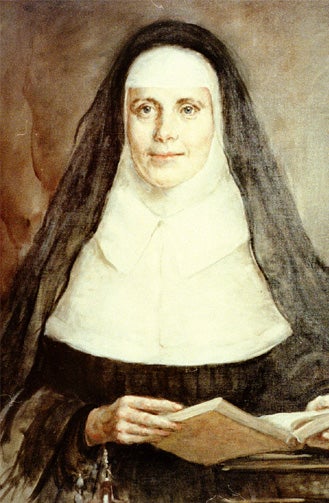Who Was Catherine McAuley?
Catherine was an Irish woman who lived in 19th-century Dublin, where most Irish Catholics existed in destitute poverty, lacking both education and opportunity, in a society that actively discriminated against them based on their Irish identity and Catholic religion.
Catherine’s father had been a master builder, so her family was relatively comfortable until after he died in 1783 when the family’s fortunes declined. Catherine inherited her father’s deep love for the Catholic faith and his generosity towards the poor.
McAuley's Beginnings
At the age of twenty, she went to live with a wealthy, older couple, William and Catherine Callaghan and became their companion and the household manager of their estate, Coolock House. She began catechetical instructions with the household servants, gave practical assistance to the poor in the village of Coolock, and taught the Catholic faith as well as basic literacy skills to Catholic children in the hedgerow schools. She adopted and reared nine children: five orphaned nieces and nephews and four of her deceased cousin’s small children.
William Callaghan supported Catherine’s works of Mercy, and on his death in 1822, he left his entire fortune to her. This enabled her to expand her Mercy outreach. She built a large house on Baggot Street in an affluent part of Dublin. Her clear intention was to bring the rich into daily contact with the poor hoping they would be moved to assist them and join her in her efforts.
She had to deal with opposition from both family and the Church. But her trust in Divine Providence was unwavering. Catherine was almost 50 when the House of Mercy opened on the Feast of Our Lady of Mercy, Sept. 24, 1827.

Catherine McAuley, RSM, lived from 1778-1841
"The Sisters of Mercy"
Many volunteers were attracted by Catherine’s spirit and inspired by her works. Among them, a core group of twelve women moved into Baggot Street permanently, devoting themselves to the works of the House of Mercy and living a community life.
The question of their status gradually became serious, and Archbishop Murray of Dublin and several others among Catherine’s friends and advisors encouraged Catherine to consider establishing a Religious Order to guarantee the stability and continuity of their work. After careful discernment, Catherine agreed to this proposal on the condition that her Sisters would not be bound by the Church Laws of cloister and enclosure, which characterized Religious Life for women at that time. Her concern was that their freedom to work among the poor and vulnerable on their own terms would be hampered by such restrictions.
Hence, on Dec. 12, 1831, at the age of 52, Catherine and two younger companions professed their Vows as the first Sisters of Mercy. They became known as the “Walking Nuns” and the Spiritual and Corporal Works of Mercy defined the apostolate of the new Religious Order named “The Sisters of Mercy.”
Her Continuing Impact
Catherine died just 10 years later, but not before she had seen the founding of eight Convents of Mercy throughout Ireland and two in England and the planning of a foundation in Newfoundland. The Order continued to spread rapidly in the English-speaking world.
One of the Irish foundations, Charleville, sent the first seven Sisters of Mercy to Bathurst in 1866 at the request of the first Bishop of Bathurst, Most Rev. Matthew Quinn. And from here, the Sisters established Mercy foundations all up the Western line as far as Bourke. They helped set up the Catholic School system across Central and Western NSW, cared for orphaned and abandoned children, and visited hospitals, prisons and people in their own homes. Over time, they also became involved in health and aged care and the delivery of other social services.
At the instigation of the Second Vatican Council in the 1960s, the Sisters of Mercy undertook a program of adaptation and renewal, resulting in a broadening of Mercy works to respond to new social challenges locally and globally.
Global Expansion
In 2011, the Bathurst Congregation of the Sisters of Mercy joined other Mercy Congregations in Australia and Papua New Guinea to form the Institute of the Sisters of Mercy of Australia and Papua New Guinea. Their Works of Mercy are supported and continued by lay groups and colleagues such as Mercy Associates, Mercy Ministry Companions, Mercy Partners, and Mercy Works Inc. Mercy International, based at the original House of Mercy in Baggot Street, Dublin, which links Sisters of Mercy worldwide.
Catherine McAuley continues to inspire both men and women to respond to situations of injustice and poverty with the Gospel values of compassion and mercy.



